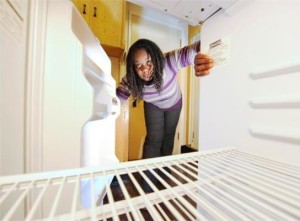In Durham, North Carolina, over 20,000 students—just about 65% of all the students in the district—receive a >>free or reduced lunch at school. Statewide, over >>50% of students are enrolled in free or reduced lunch programs.
School lunch programs are great — but they provide students meals only when school is in session. For the past two weeks, most North Carolina public schools have been unexpectedly shuttered due to snow.
Families living with food insecurity rely on school lunch programs to provide their children with meals; they count on it. So what happens when there’s a snow day? What happens when there has been almost two consecutive weeks of snow days?
“We are delivering to as many places as we can today,” Ashton Chatham Tippins said in advance of the 4-8 inches of snow expected last Wednesday night. Tippins is the Executive Director of >>TABLE — a nonprofit that provides food aid to 400 children every week in Chapel Hill and Carrboro, NC. TABLE delivers food to these children using schools, after school centers, community centers, and public housing as drop off points.
On snow days, TABLE tries to plan ahead to get the food to kids early, adding a little extra food just in case. When school was out all last week, TABLE brought food to as many of their drop sites as were open, and made sure that the kids received their >>Weekend Meal Backpack when school opened on Monday.
“Many programs aimed at feeding children in need are tightly intertwined if not directly connected with school,” writes Earline Middleton from the >>Food Bank of Central and Eastern North Carolina. Schools serve as the point of contact for children to receive food aid from organizations such as The Food Bank of North Carolina and TABLE, which distribute their >>Weekend Power Pack and >>Weekend Meal Backpack respectively through the public school system.
When schools close unexpectedly, increased pressure is placed on other local agencies that provide food aid such as shelters, food pantries, and rescue missions.
School closings have a “really significant impact” on the food pantries, according to Elizabeth Newman, who manages the food and clothing pantries for >>Urban Ministries of Durham. Newman talks about a mom who recently arrived at the Ministry in tears because, without the support of the school food aid program, her family had run completely out of food. Over the next two weeks, Newman expects there will be “tremendous need” as the kids return to school and parents and caregivers can make it over to the food pantry.
Unexpected closures also can cause families who do not typically rely on food aid to find themselves in need. “Our pantry and other pantries are there to help families out,” Newman highlighted. No one should feel that pantries are “not for them.”
Should you find yourself or your family in need, >>there are places to go for assistance.
If you don’t need help, you can be of help. >>TABLE is “always in need of food and funds to provide enough food for the kids,” said Tippins. Plus, they are looking for volunteers to bag and deliver food. >>Urban Ministries of Durham thrives on volunteers who collectively donate 3,800 hours per month. The >>Food Bank of Central and Eastern North Carolina is also always in need of food and monetary donations. Donating money, food, or time is a way to help support local families in your community.
>> Melissa Geil is a freelance writer and English teacher. Although originally from New York, she moved to North Carolina the first time for college (go Tar Heels), and now she is back to stay. She enjoys reading, hiking, and gallivanting around the triangle with her family.
Melissa Geil is a freelance writer and English teacher. Although originally from New York, she moved to North Carolina the first time for college (go Tar Heels), and now she is back to stay. She enjoys reading, hiking, and gallivanting around the triangle with her family.

There are no comments
Add yours